Close-Up Look at a Jet Near a Black Hole
[top right] - A visible light image of the giant elliptical galaxy M87, taken with NASA Hubble Space Telescope's Wide Field Planetary Camera 2 in February 1998, reveals a brilliant jet of high-speed electrons emitted from the nucleus (diagonal line across image). The jet is produced by a 3-billion-solar-mass black hole.
[bottom] - A Very Long Baseline Array (VLBA) radio image of the region close to the black hole, where an extragalactic jet is formed into a narrow beam by magnetic fields. The false color corresponds to the intensity of the radio energy being emitted by the jet. The red region is about 1/10 light-year across. The image was taken in March 1999.| Diese Datei ist gemeinfrei (public domain), da sie von der NASA erstellt worden ist. Die NASA-Urheberrechtsrichtlinie besagt, dass „NASA-Material nicht durch Urheberrecht geschützt ist, wenn es nicht anders angegeben ist“. (NASA-Urheberrechtsrichtlinie-Seite oder JPL Image Use Policy). |  | |
 |
Warnung:
|
Relevante Bilder
Relevante Artikel
RadioteleskopRadioteleskope sind Instrumente zum Empfangen und Messen der aus dem Weltall bzw. von speziellen Himmelsobjekten kommenden Radiofrequenzstrahlung. Sie sind das wichtigste Hilfsmittel der sogenannten Radioastronomie. .. weiterlesen
Interferometer (Radioastronomie)Ein Interferometer aus Radioteleskopen wird benutzt, um mit vielen kleineren Einzelanlagen eine hohe Winkelauflösung zu erreichen. Diese führt zu trennscharfen Bildern nahe beieinander liegender Radioquellen oder kompakter Quasare und ist auch bei räumlich ausgedehnten Strahlungsquellen von großer Bedeutung. .. weiterlesen
Messier 87Messier 87 ist eine 8,6 mag helle elliptische Riesengalaxie mit einer Flächenausdehnung von 8,3′ × 6,6′ im Sternbild Jungfrau auf der Ekliptik. M87 ist eine sehr aktive Galaxie, die als Radioquelle mit Virgo A, als Röntgenquelle mit Virgo X-1 bezeichnet wird. Die etwa 55 Mio. Lichtjahre von der Milchstraße entfernte Galaxie befindet sich nahe dem Zentrum des Virgo-Galaxienhaufens, dessen größtes Mitglied sie ist, obwohl sie an Helligkeit im visuellen Bereich des Spektrums von M49 übertroffen wird. Die Masse von M87 beträgt innerhalb eines Radius von 100.000 Lichtjahren (32 kpc) etwa 2 bis 3 Billionen Sonnenmassen. .. weiterlesen















